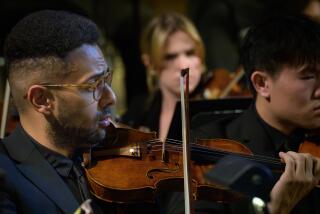ROME CHAMBER ENSEMBLE TO MAKE COUNTY DEBUT
- Share via
Famous chamber groups have come out of the Eternal City before, but there are a few differences about the fledgling International Chamber Ensemble of Rome, according to its founder-director, Francesco Carotenuto.
In the first place, all of its 23 members are not Italian but were deliberately chosen to reflect a diversity of backgrounds.
“In Rome, there are very many musicians who represent a real cross section of many nationalities,” said Carotenuto, 36. “They learn the Italian style of playing, and we learn their styles. We exchange our different knowledge. So it is a double learning experience.”
Further, according to orchestral manager Marilee Carotenuto, the conductor’s wife, the ensemble is unusual for being started with private funds.
“It receives no state funding--which is unheard of in Italy,” she said. “All other (art groups) are state run.”
The results can be sampled when the ensemble makes two Orange County stops on its current--and first--U.S. tour: at 8 p.m. on Saturday at Saddleback College in Mission Viejo and at 8 p.m. on Monday at South Coast Repertory in Costa Mesa. (The SCR date is sponsored by the South Coast Symphony.) The programs will be different for each concert.
“It is an ambitious project to try to put all these people together and come out with an orchestra that is really homogeneous,” Francesco Carotenuto said. “It has taken us many years to arrive at the group we have. We tried out many different people and attitudes about the way music should go. . . . It tends to make for a real lively exchange.” Because of its size, the ensemble specializes in music of the Baroque and the 20th Century.
“All 19th-Century classical music is romantic, for bigger ensembles,” Carotenuto said. “Rome has symphonies and operas but not a chamber ensemble with winds and percussion (as we have).”
Not that he shies away from the romantic; at home, extra players are called in for the group’s annual concert series, which begins with chamber works and evolves toward such full-sized orchestral repertory as Tchaikovsky’s Piano Concerto No. 1, according to the conductor.
But expense prohibits bringing more than 23 musicians on tour, he said. As it is, the 20-day, 12-concert tour will cost the ensemble approximately $100,000. (The Italian government is helping to underwrite the tour, Carotenuto said.)
Although Baroque music holds a major place in the ensemble’s repertory, Carotenuto prefers not to enter the debate over authentic performance practices.
But Carotenuto does reject the notion that period instruments--or replicas--need to be used.
“I feel the very idea of saying (that) Beethoven must be played on a piano of his day is merely a thing of (current) fashion,” he said.
“Composers have in mind a lot more than is available from instruments of their time. And Beethoven’s music comes off better with our instruments.”
Carotenuto should know. He began his career as a violinist and was a member of the Virtuosi di Roma in 1973-78. Although he said, “my feelings are more akin to conducting,” he also composes and teaches composition at the Accademia di Santa Cecilia in Rome.
“It’s sad. Beethoven’s piano had the sound of his day; but there was the sound he had in his head. His music was obviously written for a keyboard better developed than he had at his time. You can feel it in his music.”
More to Read
The biggest entertainment stories
Get our big stories about Hollywood, film, television, music, arts, culture and more right in your inbox as soon as they publish.
You may occasionally receive promotional content from the Los Angeles Times.










